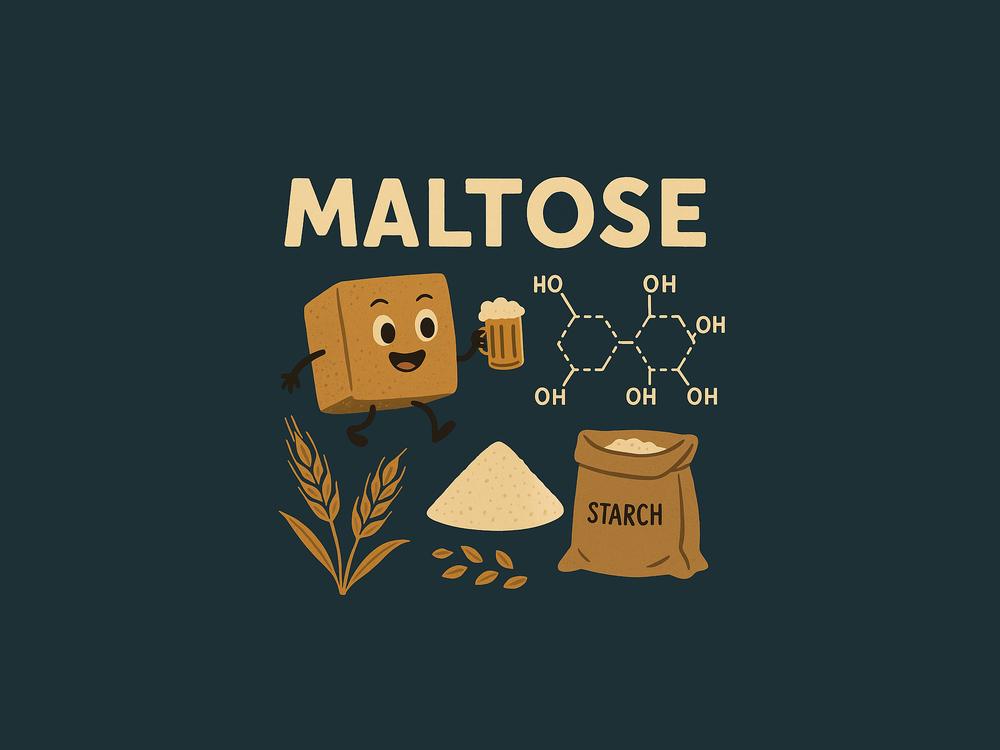
Understanding Maltose, the Sugar That Makes Whisky Possible
Published November 19, 2025 by John Fegan
Contents
Human beings have always been peculiarly vulnerable to sugar, especially after it decides to undergo that astonishing biochemical career change and become alcohol. This is the central thesis behind the drunken monkey hypothesis which proposes that long before civilisation had the foresight to invent pubs, our remote ancestors were enthusiastically pursuing anything that smelled encouragingly of fruit, fermentation, and highly questionable life choices.
Some time later, although still well before anyone had invented the concept of dinner plates, maltose appeared in our culinary history. Some genius noticed that sprouted grain produced something sweet, that the sweetness obligingly fermented into something intoxicating, and that the intoxicating result made existence on a small, mostly inconvenient planet feel slightly less like a cosmic prank.
Scientifically maltose is a disaccharide which sounds complicated until you realise it simply means two glucose molecules stuck together and refusing to separate until they reach your intestines which slice them apart with all the grace of an overworked bureaucrat armed with a letter opener and a deep sense of resignation.
People often assume sugar is sugar and that is that. The universe laughs quietly at this. It has systems. It has taxonomies. Monosaccharides. Disaccharides. Polysaccharides. Anyone who thinks this is unnecessary has never encountered a chemist, a species known for organising the cosmos one label at a time.
Where Maltose Lurks
Maltose can be found in any situation involving grains sprouting, fermentation occurring, or starch experiencing a deep philosophical crisis. It gravitates toward certain locations with the enthusiasm of a tourist armed with a poorly translated guidebook:
- Bread
- Breakfast cereals
- Crackers
- Cornmeal
- Barley
- Honey
- Molasses
- Energy bars
- Cooked sweet potatoes that have decided they are completely done with the universe
- Peaches and pears that have heard alarming whispers about enzymes
Whenever starch unravels, maltose is there watching with interest, jotting down observations like a slightly bewildered adventurer.
What Maltose Is Used For
Maltose is a very industrious sugar. It turns up in baking, cooking, and especially in the noble craft of alcohol production. In brewing it becomes the star of the wort, that warm sugary mixture that dreams in a hopeful and slightly sticky way of one day becoming beer. Or if the stars align, and the gods smile might just fulfil its secret lifelong ambition of becoming whisky.
When mashing begins, enzymes like beta amylase get to work on starch with the energy of someone trying to finish a job before anyone asks questions. Maltose ends up as one of the bigger chunks. Beta amylase operates best around sixty to sixty five degrees Celsius, which is basically a molecular spa day.
Then yeast arrives, takes one look at the maltose, and goes completely off its rocker, converting it into alcohol and carbon dioxide at a pace that makes brewers and distillers optimistic. When making beer some breweries add high maltose syrup from corn or wheat to encourage even more activity, though this isn’t generally allowed when making whisky.
Is Maltose a Reducing Sugar
Yes. Maltose can politely unfold one of its glucose units to display an aldehyde group, which is the carbohydrate equivalent of showing your papers at a particularly fussy chemistry checkpoint. Reducing sugars have the charming ability to react with mild oxidizers, which is rather impressive for something that mostly resembles glucose wearing a trench coat and hoping nobody asks questions.
Is Maltose a Pentose Sugar
No. Maltose is built from glucose, and glucose has six carbons. Two six carbon molecules will not suddenly produce a five carbon sugar unless someone has dropped, cracked, or otherwise traumatised the beaker.
Does Maltose Affect Blood Sugar
Certainly. Maltose becomes glucose, and glucose raises blood sugar with reliable enthusiasm. Some scientists suspect maltose may behave a touch differently from sucrose, but until more research arrives, most people in lab coats are carefully avoiding firm declarations in case someone publishes contradictory evidence shortly after lunch.
Is Maltose Bad For You
No. The only issue with maltose is in the same way all sugars can cause trouble when consumed without restraint. Your body uses glucose for energy. Excess glucose becomes fat. This is not a moral failure merely a biological one.
Moderation is generally the smart option, unless you happen to be yeast, which considers moderation a quaint myth told by organisms with no ambition.
Is Maltose a Protein
Absolutely not. Maltose is a carbohydrate. Proteins build things. Carbohydrates power things. Confusing them is a shortcut to disappointment and the creation of sandwiches with unfortunate mouthfeel.
Is Maltose an Enzyme
No. Enzymes are proteins that rush around speeding up chemical reactions. Maltose is the result of enzymatic work. Asking if maltose is an enzyme is like asking if the sawdust is the carpenter.
Does Yeast Digest Maltose
Yes, yeast digests maltose. And often with far more enthusiasm than expected if your fermenter lid is not firmly attached.
Yeast approaches sugar the way a very small, determined project manager approaches any task. BY arranging a meeting to discuss the proper order. It processes sucrose first, then glucose, then fructose, then maltose, and finally maltotriose. It uses invertase outside the cell for dealing with sucrose and relies on maltase inside the cell for maltose and maltotriose. Dextrins are too large and complicated, so yeast chooses to ignore them with admirable confidence.
Does Maltose Dissolve in Water
Yes. Maltose is polar, water is polar, and polar molecules cling together like a group of nervous penguins waiting for something ominous to happen. As a result, maltose dissolves eagerly. Oil, being nonpolar, opts out and sits at a comfortable distance from anything resembling cooperation.

